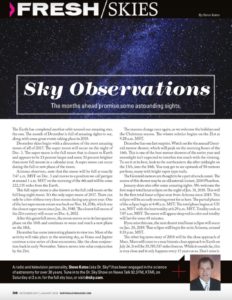The December and January skies offer some astounding sights
The months ahead promise some astounding sights.
By Steve Kates
The Earth has completed another orbit around our amazing star, the sun. The month of December is full of amazing sights to see, along with some great events taking place in 2018.
December skies begin with a discussion of the most amazing moon of all of 2017.
The super moon will occur on the night of Dec. 3. The super moon is the full moon that is closest to Earth and appears to be 13 percent larger and some 30 percent brighter than most full moons in a calendar year. A super moon can occur during the full or new phase of the moon.
Arizona observers, note that the moon will be full at exactly 7:47 a.m. MST on Dec. 3 and moves to a position we call perigee at around 1 a.m. MST on the morning of the 4th and will be some 222,135 miles from the Earth.
This full, super moon is also known as the full cold moon or the full long night moon. It’s the only super moon of 2017. There can only be a few of these very close moons during any given year. One of the last super moon events was back on Nov. 14, 2016, which was the closest super moon since Jan. 26, 1948. The closest full moon of the 21st century will occur on Dec. 6, 2052.
After this great full moon, the moon moves on to its last quarter phase on the 10th and continues to wane and reach a new phase on the 18th.
December has some interesting planets to view too. Most of the activity will take place in the morning sky, as Venus and Jupiter continue a nice series of close encounters, like the close conjunction back in early November. Saturn moves into solar conjunction, by the 21st.
The seasons change once again, as we welcome the holidays and the Christmas season.
The winter solstice begins on the 21st at 9:28 a.m. MST
December has one last surprise. Watch out for the annual Geminid meteor shower, which will peak on the morning hours of the 14th. This is one of the best meteor showers of the entire year and the moonlight isn’t expected to interfere too much with the viewing. To see it at its best, look to the northeastern sky after midnight on the 13th, into the 14th. You may get to see upwards of 50 meteors per hour, many with bright vapor type trails.
The Geminid meteors are all thought to be a part of a rock comet. The source of this shower may be an old asteroid /comet, 3200 Phaethon.
January skies also offer some amazing sights. We welcome the first major total lunar eclipse on the night of Jan. 31, 2018. This will be the first total lunar eclipse seen from Arizona since 2015. This eclipse will be an early morning event for us here. The partial phases of the eclipse begin at 4:48 a.m. MST. The total phase begins at 5:51 a.m. MST with the best totality at 6:29 a.m. MST. Totality ends at 7:07 a.m. MST. The moon will appear deep red in color and totality will last for some 68 minutes.
If you miss this one, the next decent total lunar eclipse will occur on Jan. 20, 2019. That eclipse will begin for us in Arizona, around 8:33 p.m. MST.
The other big news story of 2018 will be the close approach of Mars. Mars will come to a near historic close approach to Earth on July 26. It will be 35,785,537 miles from us. While it sounds far, this is very close and it only happens every 15 years or so. Don’t miss it.
Related posts
Leave a Comment
You must be logged in to post a comment.







